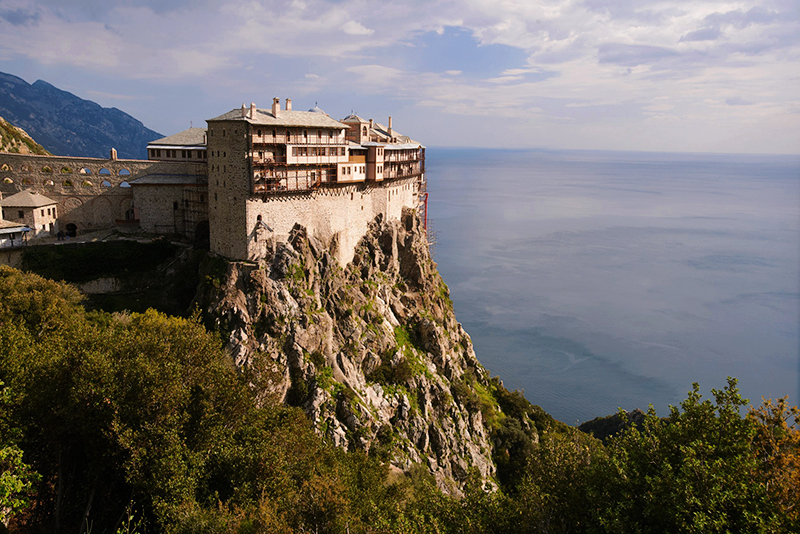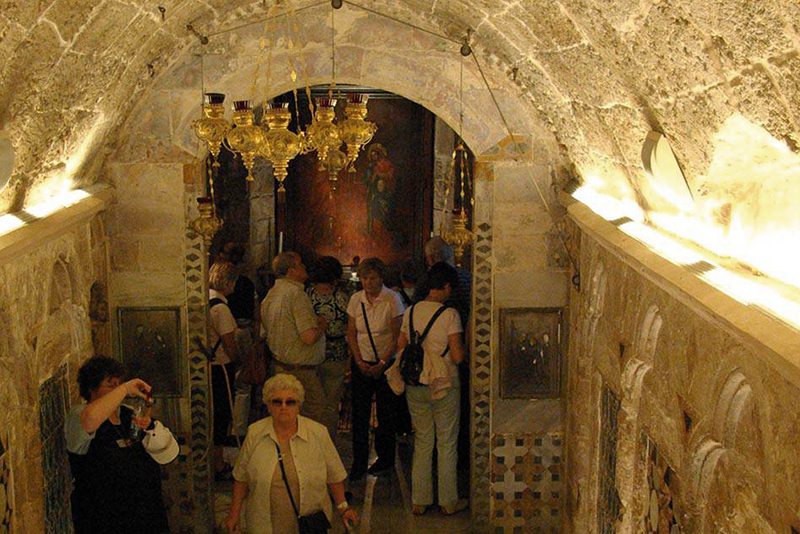
It Is Truly Meet
I have no talent for languages. Like many, I learned them unsystematically. In school I had no motivation to learn foreign languages and devoted more time to other studies. By the time I realized that I was missing something important, I was already in my forties, and my underdeveloped abilities as a potential polyglot were dying of old age. Knowing at least some basic English is an absolute must for a pilgrim on Athos. However, every day of our journey, there were people around who helped us overcome the language barrier, and we experienced no communication problems. This time was no exception. As soon as we sat down on warm stones next to our backpacks and began deciding what to do next, two young men from Ukraine suddenly appeared “entirely by accident”. They asked me for a blessing and volunteered to show us the Protaton Church of the Dormition of the Most Holy Theotokos.
Here is some information about this church, which I have found in the depths of the Internet, namely from the Orthodox site orthochristian.com:
In 335 the Equal-to-the-Apostles Emperor Constantine the Great erected on the site of a pagan temple the first church on the Holy Mountain in honor of the Dormition of the Most Holy Theotokos. Today it remains the spiritual center of Karyes. The first Athonite inhabitants settled around this church. The Great Lavra of Karyes, which appeared here later, flourished. Its superior became the leader of Athos and was called the Protos (first or senior). The Protos was in charge of the Council or Synod of honorary elders. Traditionally, the general meeting of the monks living on the Holy Mountain took place in Karyes on the day of the Dormition of the Most Pure Mother. This continued until the 17th century, when the Turks imposed an unbearable tribute on the Lavra, forcing it to sell plots of its land to other monasteries, thereby making them independent. Then the Council of the Holy Mountain decided to transform Karyes into a city and the center of the spiritual administration of the monastic republic. To this day, the common affairs of all the monasteries on Mount Athos are governed by the Holy Assembly, or Kinot, which gathers in the building of the Protaton. The Protaton Church of the Dormition, destroyed and revived again many times, remained the spiritual center of Karyes. It was burned at the behest of the Emperor Julian the Apostate in 362. In the 10th century, the church was restored under the Emperor Nicephorus II Phocas, and in the fourteenth century it suffered greatly at the hands of the Latins and was later rebuilt again by the diligence of the Bulgarian kings. Inside the cathedral there are priceless murals by the famous 14th century Byzantine iconographer Manuel Pansenilos. Since 982, the miraculous icon of the Mother of God “Karyotissa”, known especially as “Axion Estin” (It Is Truly Meet) has been kept on the throne of the Holy Altar in the Dormition Church. Together with the church, it has been through many hardships, but remained unharmed and has been illuminating the entire Orthodox world for more than a thousand years now.
The church was literally two steps away. It rises opposite the pompous Protaton building. In front of it there is a bell tower looking like a rectangular rocket. Passing under the imaginary ‘nozzles’ of this rocket, a pilgrim finds himself in an enfilade of the extended arched corridor going along the wall of the Dormition Basilica. The low massive door turned out to be open, and we entered into the twilight of the church. For some reason, the space inside seemed squeezed and cramped to me. I stopped hesitantly in front of the miraculous icon remembering various sources saying that it should be in the altar and wondering if that was really “the one”. If that was the famous icon, then it has been moved out of the altar to the column to the left of the royal doors. But what if there is another, “real” Axion Estin? I asked a young monk who was cleaning the church for permission to enter and venerate the holy altar. First, I am a priest, and I always kiss the altar table when I walk into a church, and second, it was a tactical move, as I needed to make sure that there was no other “real” icon in this church. My excessive vigilance may seem stupid at first sight but if my dear beloved reader remembers the beginning of my story, especially the episode with the “Three-handed” icon in Thessaloniki, then perhaps he will understand why “the scalded dog was fearing cold water”.
In the altar on the synthronon there was an icon of the Savior, and no sign of any other “Karyotissa” was seen. With a feeling of shame and reverence, I came back and stood on my knees before the miraculous image, now available in its new location to all people entering the church. Like all miracle-working images, the icon was hung with offerings in gratitude for the prayers heard by the Mother of God. I took out of my backpack my stack of reprints of our Children’s Icon “It is Truly Meet”, and pressing them against the glass of the icon case, began to talk with the Most Pure. Of course, this was my monologue with words of gratitude for the fact that I was “honored” to venerate the glorified image. I was asking the Mother of God for the children living in my parish and asked her to bestow Her grace upon our church. I asked for the sick over and over again… I was focused on my petitions and not noticing anything happening around or inside me. Meanwhile, inside I felt as I did in childhood, when my parents put me in bed, while they were quietly going about their business somewhere nearby. I felt comfort and safety; everything was good and quiet at home…
Translated by The Catalogue of Good Deeds




